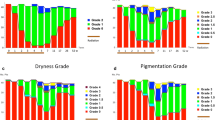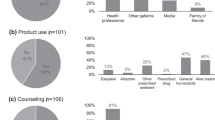Abstract
Purpose:
To evaluate radiation dermatitis objectively in patients with breast cancer who had undergone post-operative radiotherapy after breast-conserving surgery.
Patients and Methods:
Skin color (L*, a*, and b* values) and moisture analyses were performed for both breasts (before, after, 1 month, 6 months, and 1 year after radiotherapy) to examine irradiated and non-irradiated skin divided into four quadrants in 118 patients. These patients underwent breast conservative surgery followed by 50 Gy/25 fractions (median) of radiotherapy with or without boost irradiation (10 Gy/5 fractions).
Results:
L*, a*, and moisture values were changed by irradiation and maximized at completion or 1 month after radiotherapy. One year after radiotherapy, the skin color had returned to the range observed prior to radiotherapy. However, moisture did not return to previous values even 1 year after treatment. The lateral upper side (quadrant C) showed greater changes than other quadrants in the L* value (darker) at the end of radiotherapy. The Common Toxicity Criteria version 3 scores were found to correlate well with a* and L* values at the completion and 1 month after radiotherapy. Boost radiotherapy intensified reddish and darker color changes at the completion of radiotherapy, while chemotherapy did not intensify the skin reaction caused by radiotherapy.
Conclusion:
Moisture impairment as a result of irradiation lasts longer than color alterations. Objective assessments are useful for analyzing radiation dermatitis.
Zusammenfassung
Hintergrund und Ziel:
Objektive Bewertung von Strahlendermatitis bei Brustkrebspatienten, die nach einer brusterhaltenden Operation mit Strahlentherapie behandelt wurden.
Patienten und Methoden:
Wir analysierten die Hautfarbe (L*a*b*-Werte) und Feuchtigkeit an beiden Brüsten (vor und nach der Strahlentherapie sowie einen Monat, sechs Monate und ein Jahr danach), um bei 118 Patienten die bestrahlte und die nichtbestrahlte Haut nach Einteilung in vier Quadranten zu untersuchen. Diese Patienten unterzogen sich einer brusterhaltenden Operation, gefolgt von Strahlentherapie mit 50 Gy in 25 Fraktionen (Medianwert) mit oder ohne Boost-Bestrahlung (10 Gy in 5 Fraktionen).
Ergebnisse:
Die Werte für L*, a* und Feuchtigkeit wurden durch Bestrahlung verändert und beim Abschluss oder einen Monat nach der Strahlentherapie maximiert. Ein Jahr nach der Strahlentherapie hatte die Haut den vor der Strahlentherapie beobachteten Farbewerte-Bereich zurückgewonnen. Allerdings war die Feuchtigkeit auch ein Jahr nach Abschluss der Strahlenbehandlung nicht wieder im ursprünglichen Wertebereich. Der obere äußere Quadrant (Quadrant C) wies nach Abschluss der Strahlentherapie beim L*-Wert (dunkler) größere Veränderungen auf als die anderen Quadranten. Bei den Allgemeinen Toxizitätskriterien (CTC Version 3) ergab sich eine gute Korrelation mit den a*- und L*-Werten beim Abschluss und einen Monat nach der Strahlenbehandlung. Boost-Strahlentherapie verstärkte rötliche und dunklere Farbveränderungen beim Abschluss der Strahlentherapie, wogegen Chemotherapie die von Strahlentherapie verursachten Hautreaktionen nicht verstärkte.
Schlussfolgerung:
Beeinträchtigung der Feuchtigkeit in Folge der Bestrahlung hält länger an als Farbveränderungen der Haut. Objektive Bewertungen sind für die Analyse von Strahlendermatitis hilfreich.
Similar content being viewed by others
References
Abo-Madyan Y, Polednik M, Rahn A, et al. Improving dose homogeneity in large breasts by IMRT: efficacy and dosimetric accuracy of different techniques. Strahlenther Onkol 2008;184:86–92
Arbogast JW, Fendler EJ, Hammond BS, et al. Effectiveness of a hand care regimen with moisturizer in manufacturing facilities where workers are prone to occupational irritant dermatitis. Dermatitis 2004;15:10–7
Clarys P, Alewaeters K, Lambrecht R, et al. Skin color measurements: comparison between three instruments: the Chromameter (R), the DermaSpectrometer (R) and the Mexameter (R). Skin Res Technol 2000;6:230–8
Dolotov LE, Sinichkin YP, Tuchin VV, et al. Design and Evaluation of a Novel Portable Erythema-Melanin-Meter. Lasers in Surgery and Medicine 2004;34:127–35
Fehlauer F, Tribius S, Alberti W, et al. Late effects and cosmetic results of conventional versus hypofractionated irradiation in breast-conserving therapy. Strahlenther Onkol. 2005;181:625–31
Fisher J, Scott C, Stevens R, et al. Randomized phase III study comparing Best Supportive Care to Biafine as a prophylactic agent for radiationinduced skin toxicity for women undergoing breast irradiation: Radiation Therapy Oncology Group (RTOG) 97-13. Int J Radiat Oncol Biol Phys 2000;48:1307–10
Frieben H. Demonstration eines Cancroid des rechten Handruckens, das sich nach langdauernder Einwirkung von Rontgenstrahlen entwickelt hatte. Fortschr Rontgenstr 1902;6:106–11
Heinrich U, Koop U, Leneveu-Duchemin MC, et al. Multicentre comparison of skin hydration in terms of physical-, physiological- and product-dependent parameters by the capacitive method (Corneometer CM 825). Int J Cosmet Sci 2003;25:45–53
Hoeller U, Borgmann K, Feyer P, et al. Organgruppe “Mammakarzinom” der DEGRO. [On the interaction of adjuvant radiotherapy and tamoxifen treatment for breast cancer]. Strahlenther Onkol 2007;183:535–44
Hymes SR, Strom EA, Fife C. Radiation dermatitis: Clinical presentation, pathophysiology, and treatment. J Am Acad Dermatol 2006;54:28–46
Inomata T, Ogawa Y, Nishioka A, et al. Changes in blood flow and skin reaction following radiation therapy. Nippon Igaku Hoshasen Gakkai Zasshi (in Japanese) 1995;55:58–64
Kawashima M, Nozaki N, Furuta M, et al. Objective assessment of breast skin reactions after breast-conserving therapy. J Jpn Soc Ther Radiol Oncol 2007;19:273–6
Maddocks-Jennings W, Wilkinson JM, Shillington D. Novel approaches to radiotherapy-induced skin reactions: A literature review. Complementary Therapies in Clinical Practice 2005;11:224–31
Momm F, Bartelt S, Haigis K, et al. Spectrophotometric skin measurements correlate with EORTC/RTOG-common toxicity criteria. Strahlenther Onkol 2005;181:392–5
Nuutinen J, Lahtinen T, Turunen M, et al. A dielectric method for measuring early and late reactions in irradiated human skin. Radiother Oncol 1998;47:249–54
Ott OJ, Lotter M, Sauer R, et al. Accelerated partial-breast irradiation with interstitial implants: the clinical relevance of the calculation of skin doses. Strahlenther Onkol 2007;183:426–31
Park SB, Suh DH, Youn JI. A long-term time course of colorimetric evaluation of ultraviolet light-induced skin reactions. Clin Exp Dermatol 1999;24:315–20
Polgár C, Strnad V, Kovács G. Partial-breast irradiation or whole-breast radiotherapy for early breast cancer: a meta-analysis of randomized trials. Strahlenther Onkol 2010;186:113–4
Rades D, Bohlen G, Dunst J, et al. Comparison of short-course versus longcourse whole-brain radiotherapy in the treatment of brain metastases. Strahlenther Onkol 2008;184:30–5
Sautter-Bihl ML, Budach W, Dunst J, et al. German Society of Radiation Oncology;German Cancer Society. DEGRO practical guidelines for radiotherapy of breast cancer I: breast-conserving therapy. Strahlenther Onkol 2007;183:661–6
Sekine H, Sugenoya J, Fukuda I, et al. Long-term, irradiation-induced effects on thermoregulation in the skin after thermal stimulation. Radiat Med 2004;22:413–21
Serup J, Agner T. Colorimetric quantification of erythema–a comparison of two colorimeters (Lange Micro Color and Minolta Chroma Meter CR-200) with a clinical scoring scheme and laser-Doppler flowmetry. Clin Exp Dermatol 1990;15:267–72
Souchon R, Budach W, Dunst J, et al. Whole-breast irradiation following breast-conserving surgery of ductal carcinomain situ is indispensable. Update of the 2005 DEGRO (German Society of Radiation Oncology) Guideline on Radiation Therapy for Breast Cancer] Strahlenther Onkol 2006;182: 429–30
Voordeckers M, Vinh-Hung V, Lamote J, et al. Survival benefit with radiation therapy in node-positive breast carcinoma patients. Strahlenther Onkol 2009;185: 656–62
Wei L, Xuemin W, Wei L, et al. Skin color measurement in Chinese female population: analysis of 407 cases from 4 major cities of China. Int J Dermatol 20074;6:835–9
Zibold F, Sterzing F, Sroka-Perez G, et al. Surface dose in the treatment of breast cancer with helical tomotherapy. Strahlenther Onkol 2009;185: 574–81
Author information
Authors and Affiliations
Corresponding author
Rights and permissions
About this article
Cite this article
Yoshida, K., Yamazaki, H., Takenaka, T. et al. Objective Assessment of Dermatitis Following Post-operative Radiotherapy in Patients with Breast Cancer Treated with Breast-conserving Treatment. Strahlenther Onkol 186, 621–629 (2010). https://doi.org/10.1007/s00066-010-2134-1
Received:
Accepted:
Published:
Issue Date:
DOI: https://doi.org/10.1007/s00066-010-2134-1




